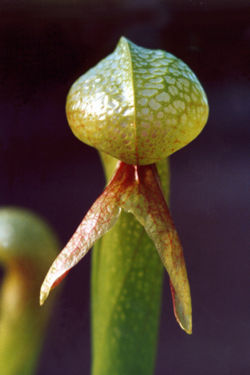
- Kingdom: Plantae
- Subkingdom: Tracheobionta
- Superdivision: Spermatophyta
- Division: Magnoliophyta
- Class: Magnoliopsida
- Subclass: Dilleniidae
- Order: Nepenthales
- Family: Sarraceniaceae
- Genus: Darlingtonia
- Species: D. californica
Darlingtonia californica
| California pitcherplant |
|---|
 |
| Scientific Classification |
|
| Binomial Name |
Darlingtonia californica |
The California pitcherplant is a species of carnivorous pitcher plants (Darlingtonia californica), also known as the cobra plant or cobra lily. It is somewhat uncommon and found in Northern California and some parts of Oregon.
It gets the name cobra lily because the stem and leaves look like a cobra. It also has a forked leaf that looks like a snake's tongue. It was discovered by botanist William D. Brackenridge at Mt. Shasta in 1841. John Torrey later described the plant (in 1853). Torrey named the genus Darlingtonia after the botanist William Darlington of Philadelphia.[1]
The California pitcher plant's leaves are, for the most part, green. When grown in direct, full sun light the leaves have a more red tinge. This species has two different forms. The most commonly seen form is the one that has a purple flower and looks like a snakes head. The other form has a yellow flower and is quite rare. They can grow up to 2 feet tall.
The trap is a tube with a rotund dome at the top. It's nectar gland attracts prey to its mouth(mouth is under dome. the dome is translucent in many spots, this allows light to pass through. When the prey enters the bulb they are tricked into thinking there is a way out. The tube has lots of little hairs that all point downward. The insect slides down these hairs to the trap at the bottom. Once the insect is in the trap the cobra lily creates a fluid. Unlike many other plants the cobra lily's digestive fluid doesn't have any known enzymes or wetting agents. The leaves seem to die when the trap gets full of insects. [2]
The way California pitcher plants are pollinated is still somewhat of a conundrum. The flower is oddly shaped which brings Some scientists to believe it is a close pollinator-plant, however none have ever been identified. Some think that some kind of insect pollinates the plant, but no extensive studies have been preformed to test this theory.[3]
To cultivate this plant is actually are fairly simple feat for those who know how to garden, as long as you keep the roots in a cool damp environment. The soil should be made of sphagnum moss peat, lime free silver sand, perlite, and live sphagnum moss. The first thing you need to do is put 1-2 inches of perlite at the bottom of the pot. Then add half an inch of sphagnum moss peat. Next a mixture of 1 part peat, 1 part silver sand, and 1 part perlite. Add a little live sphagnum moss and the soil is finished. The live moss keeps the rhizomes and roots shady and moist. You need to keep this plant in an environment where there is cool night temperatures. Using a large pot is a good idea because the plant sends out runners underneath the soil. Once the plantlets have developed their own root system they can be separated and will make new plants.[4]
The California pitcher plant is rare and native only to Oregon and California. It ranges from the southern coast of Oregon to northwest California. There are some separate colonies in the northern Sierras. It is found around sphagnum bogs along coasts or inland in shady, hillside areas. There needs to be a constant supply of cool water (which these sites have). The temperature of the water is very important for the plant to stay alive. the water temperature and availability is even more important than the altitude or the temperature of the surrounding area. Usually the plant colonies are growing on a substratum of serpentine rock. Serpentine rock is toxic to most other plants.
The serpentine and bog area that the cobra lily resides in are actually a bit of a problem. The problem is there is a very low amount of nutrients. The bogs have a high level of acidity and a low organic matter turnover, this creates the low nutrient problem. It has low concentrations of nitrogen, phosphorus and calcium. Serpentine-derived soils are rich in magnesium and other heavy metals, most plants can't survive in these conditions. In order to survive the cobra lily eats insects to get its nutrients.[5]
|
||||||||||||||||||||